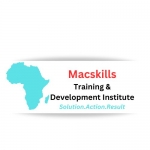|
|
Gis Data Collection, Management, Analysis, Visualization And Mapping Workshop
USD 2,450 |
Venue: Nairobi
This training introduces students to both the social and technical aspects of digital mapping. Students will learn fundamental concepts and techniques in cartography and GIS, including file types, data classification, projections and coordinate systems and elementary analytical techniques in a range of desktop and web-based mapping platforms. In addition to providing the fundamental technical competencies necessary to create maps, students will develop the critical awareness required to effectively communicate complex social processes through maps. This course comprises 10 modules, each with their own learning objectives and target deliverable. Modules consist of an applied "hands-on" lesson.
Duration 10 Days
Target Audience
The course targets government representatives, project teams, NGOs, multi and bilateral development organizations, consultancies, etc., who work as M&E specialists, project managers, researchers, and technical specialists.
Objectives
By the end of this course the participants will be able to:
- Define and differentiate between variety of spatial data models and formats.
- Explain and apply the basics of representation in GIS, (including using vector and raster data formats, determining appropriate geographic coordinate system for a given spatial data file and applying the appropriate geographic projection to a map type and spatial scale)
- Manipulate geospatial datasets (e.g. cleaning, joining, querying, extracting)
- Apply appropriate thematic map symbology to represent geographic phenomena.
- Produce static map products that integrate multiple data types and analytical methods.
- Obtain geospatial data from a variety of online sources and integrate into mapping processes.
- Integrate desktop GIS procedures with web-based mapping platforms.
Course Outline
Module 1: Introduction to new maps plus, cartography and GIS, and creating maps in QGIS
- Basics of cartography, GIS, and mapping
- Introduction of geographic data and information and its coding
- Downloading and installing a free and open-source GIS application (QGIS)
- QGIS interface
- Spatial reference and projection issues
- Working with geographic data with QGIS and viewing their attributes within QGIS
- Basic map styling
- Creating and exporting a basic map as a static image file
Module 2: Thematic data mapping with table joins.
- Load shape files and CSV data into QGIS
- Reproject the map into an equal area projection
- Create classed choropleth map.
- Adjusting the legend
- Load tabular CSV data into QGIS and perform a tabular join.
Module 03: Geocoding and point in polygon analysis.
- Obtain and work with US Census data.
- Geocoding of tabular data
- Online geocoding tools
- Polygon analysis points
Module 04: Hexbin and heat mapping
- Map point data.
- Create new polygon shape files of hexagon shapes and raster heat maps.
- Determine the number of different good types within each polygon.
- Play with various classification schemes for representing the data.
- Create a 'heat map' representation of the data.
Module 05: Creating and editing vector Geometries.
- Georeferencing
- Using the GDAL Georeferencer
- Data digitization
- Data digitization with Open Street Map in QGIS
Week 2
Module 06: OpenStreetMap data and Introduction to Geoprocessing tools
- Introduction to Open Street Map
- Importing OpenStreetMap data: QuickOSM
- Importing OpenStreetMap data: SpatialLite Database
- Filtering and extraction od data
- Exporting layers to a local CRS
- Introducing Geoprocessing
- Geoprocessing with a buffer analysis
Module 07: Geoprocessing in QGIS and automating workflows
- Extracting and preparing thematic OSM data
- Filtering OSM data to create desired features.
- Managing CRSs in a Geoprocessing Workflow
- Extracting attribute types of interest
- Creating a buffer around a Polyline feature
- Clipping features within a buffer
- Geoprocessing functions
- Using the Graphical Processing Modeler to automate workflows.
Module 08: Integrating QGIS with cartodb
- Creating a CartoDB account and exploring the documentation and interface
- Loading data into CartoDB
- Using the QGIS CartoDB plugin
- Pulling data down into QGIS for processing
- Pushing data backup to CartoDB
- Making a thematic map in CartoDB
Module 09: Advanced mapping techniques with QGIS and cartodb
- Using SQL in CartoDB
- Symbolizing point data and "Bubble Maps" in CartoDB
- Creating an unclassed proportional symbol map in CartoDB
- What is PostGIS?
- Using SQL and PostGIS to perform Geoprocessing tasks in the browser
Module 10: Bringing it all together (course project)
- Each student will select from suggested datasets to create a final course project.
- Students can use CartoDB or Mapbox Studio
Certification
- Upon successful completion of this training, participants will be issued with Macskills Training and Development Institute Certificate
Training Venue
- Training will be held at Macskills Training Centre. We also tailor make the training upon request at different locations across the world.
Airport Pick Up and Accommodation
- Airport pick up and accommodation is arranged upon request.
| Nairobi | Dec 09 - 20 Dec, 2024 |
| USD 2,450.00 | |
Mackskills Development Institute +2541140877180




.png)